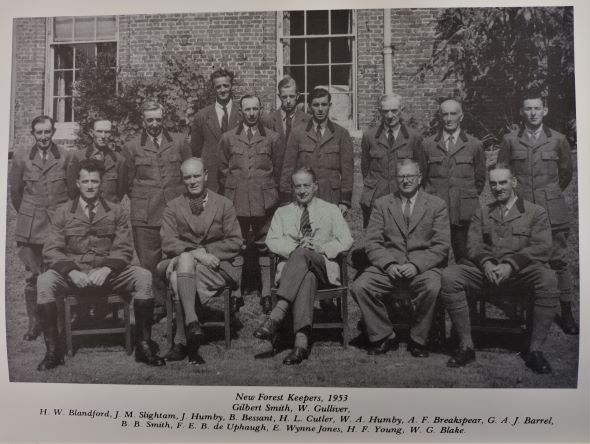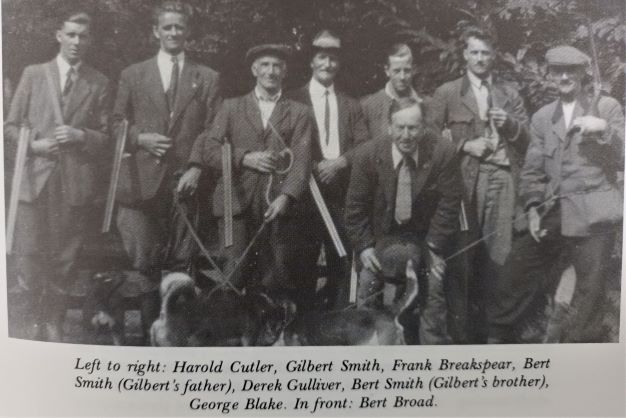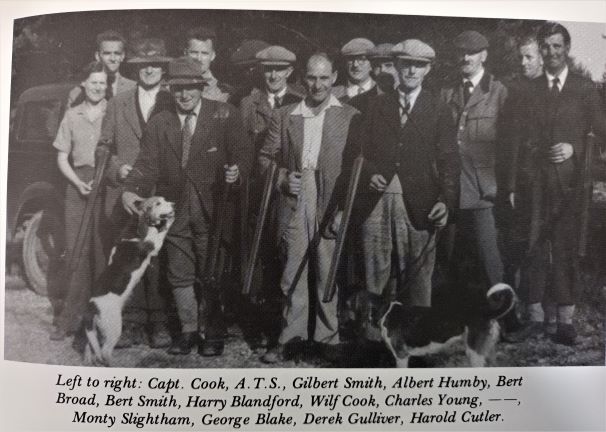Fritham is a village in the north of the New Forest, 6.5 miles north-west of Lyndhurst.
| Name | Occupation | Posted from | Until |
|---|---|---|---|
| Second Lieutenant Gerald Forward | Agister of New Forest |
23 Jul 1940 | 01 Apr 1944 |
| Sergeant Bertie Benjamin Smith | Crown Forestry Keeper |
23 Jul 1940 | 03 Dec 1944 |
| Private William Charles Gulliver | Forester - Government timber cutter |
19 Apr 1944 | 03 Dec 1944 |
| Private Alfred Henry Hollands | Butcher (Shopkeeper) |
11 Sep 1942 | 03 May 1944 |
| Private Allister Thomas Holloway | Forest keeper / Foreman |
08 May 1941 | 03 Dec 1944 |
| Private Gilbert William Ernest Smith | General labourer & forest keeper |
25 Jan 1941 | 03 Dec 1944 |
| Private William Thorne | Forest worker |
25 Jul 1940 | 03 Dec 1944 |
The Patrol had one Operational Base which consisted of a caravan buried completely underground, with a disguised entrance in “a part of the Forest which was difficult to get to”. The caravan belonged to the Crosthwaite-Eyre family, well known in the New Forest, with various members representing the area as MP, as Official Verderer and during the war as commander of the local Home Guard. Gerald Forward checked with John Crosthwaite-Eyre, who he knew was involved in similar work, though it is not clear if he knew how much, since John was pictured at Coleshill House around this time. The caravan was carefully hitched to a tractor at just after 1pm, when the rest of the staff had gone to lunch and driven off. It was buried by the following morning.
The Patrol also had a more typical corrugated iron shelter, though the wood for this was acquired from one of the Forest bridges ! It no longer exists as it was dug up by Gerald Forward for use as a pigsty after the war. Gilbert Smith describes burying an “Elephant shelter” (heavy grade Nissen for underground use) in an old disused sandpit, near a badger sett on the side of a hill. This dates it’s construction to 1941 at the earliest. It is thought that this may have been in Bramshaw Wood.
The OB contained a bunks, a table with stools and oil stove. There was the usual 2 gallon rum jar, and a stock of drinking water which was changed regularly. What is intriguing is that Gilbert Smith mentions a couple of times that they had a radio in the OB – and could transmit with this if necessary. It was quite unusual for Patrols to have a radio and this may have been because of the isolated nature of the Forest Patrols.
Fritham Patrol
One Thursday the Patrol went to ground in their OB, following an alert that invasion was imminent. Auxiliary Units were meant to avoid the initial battle and surface after the initial fighting was over and wreak havoc behind the lines. However, they heard no fighting, or anything else to suggest the presence of enemy forces. Eventually, 3 days later on the Sunday, they sent a man out to find out what had happened, obviously discovering this was a false alarm. The Patrol had heard nothing on their radio and had been told not to call out, but the Army had forgotten that they had been sent to ground and not issued a recall !
Gerald Forward reported training with Regular soldiers, possibly a Hampshire Scout Section as well as being sent away on training courses, most likely a Patrol leaders course at Coleshill House.
Gilbert Smith recalled an initial period of intensive training, mostly in explosives, as the Patrol members were already crack shots and familiar with camouflage. Army Officers visited to undertake the training, which also included first aid and rescue drill. Gilbert was aware of two other Forest Patrols, but didn’t know that the organisation was much larger.
Another exercise was to stop an Army convoy on a particular road. Live explosives were tied to a large oak branch, with a four gallon petrol tin full of water above, which would be shot full of holes with a Tommy gun as the ambush was sprung, to simulate petrol being released by the explosive and descending as a flaming mass on the truck. Two other Patrol members had flour and soot “grenades”. The plan was for the Commanding Officer to signal when to fire the detonator and trigger the ambush. Gilbert says that the unnamed Officer was rather nervous and excitable, and he failed to make the signal until three lorries had already gone through, leaving the Patrol concerned. Thus when the signal eventually came, the string connected to the detonator was pulled rather too violently, yanking the detonator out of the explosive rather than setting it off. Perhaps just as well, since a heavy oak branch might have done serious damage among the men in the back of the lorry !
The Patrol also launched a mock attack on an Army camp, with the aim being to leave time pencils (with detonators, but no explosives) on the differentials of the parked Bren carriers. The camp was told the Patrol would come on one of three nights and went on the second, when there was heavy rain. Within seven minutes the Patrol were in and out of the camp having set their time pencils, 30 in all. Twenty minutes later the time pencils went off. The Patrol had brought the Colonel of target unit from his headquarters at Minstead Hall as an independent witness of success. When the charges went off he was left rather red faced. Gilbert reports his comment, “I think I’ve got a lot of rotten troops and, I don’t know for sure, but I think you are the biggest rotters I’ve ever met !”
Just prior to the caravan episode, Gerald Forward and John Crosthwaite-Eyre made their own grenades. It is likely that this was at the stage when the Home Guard had little more than Molotov cocktails and shotguns. The grenades were made of cement contained within brown paper and filled with metal debris such as nails and tacks, with a piece of Bickford cord as the detonator. His only remark is that these were probably more dangerous to the user ! A stash of them was discovered after the war at The Warrens (the Crosthwaite-Eyre residence) and the Police called, since it wasn’t immediately clear how they had arrived there.
Gordon Thorne remembers his father having a revolver, something that would have been most unusual for a regular Home Guard, but standard issue to Auxiliers.
Gilbert Smith recalled copious explosives and ammunition, including time pencils. He was rather more surprised to receive cyanide tablets for use in case capture seemed inevitable. He had a Tommy gun. All the men would have already owned shot guns and probably rifles as well for shooting deer.
The Fritham Patrol was set up by Gerald Forward who was Patrol Sergeant from its creation until he was promoted to assistant Group Commander in April 1944. He recounted some of the details in a privately published biography.
Forward recalled how he was approached by a Staff Officer who went around the subject at some length before asking him to find the men to form a Patrol. This was apparently “quite early on” so may have been something like July to September 1940 (he also says it was after the renaming of the LDV to the Home Guard on 22nd July 1940).
Gilbert Smith was a well known Keeper, who wrote a book about his life in the Forest. The book contains photos of groups of Keepers, taken in the 1950s. These included Bert Smith and Bill Gulliver. Smith can be seen to be wearing his Aux Units enamel badge in some of the photos.
TNA ref WO199/3391
Hancock data held at B.R.A
1939 Register
Man of the New Forest by Gilbert Smith
Information from Gerald Forward’s private biography forwarded by Mr A Passmore, together with other details of Patrol members.
Information from Mr G Thorne, son of Bill Thorne.


